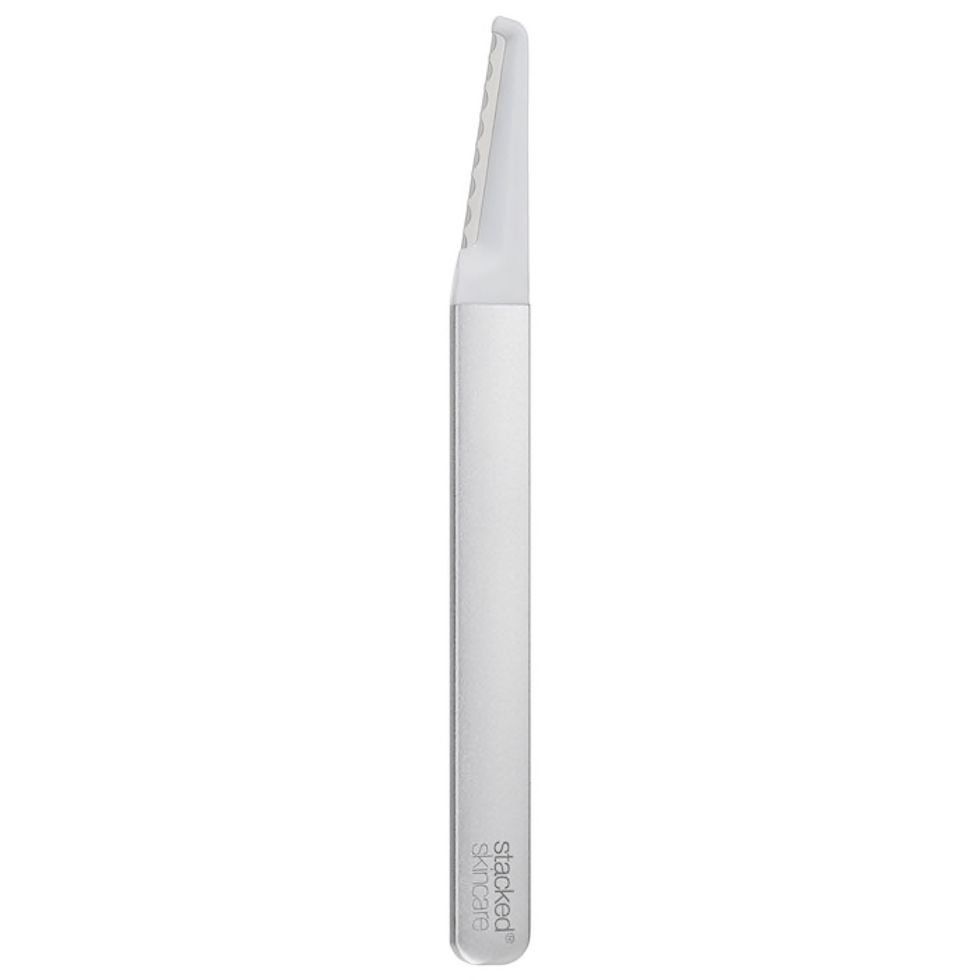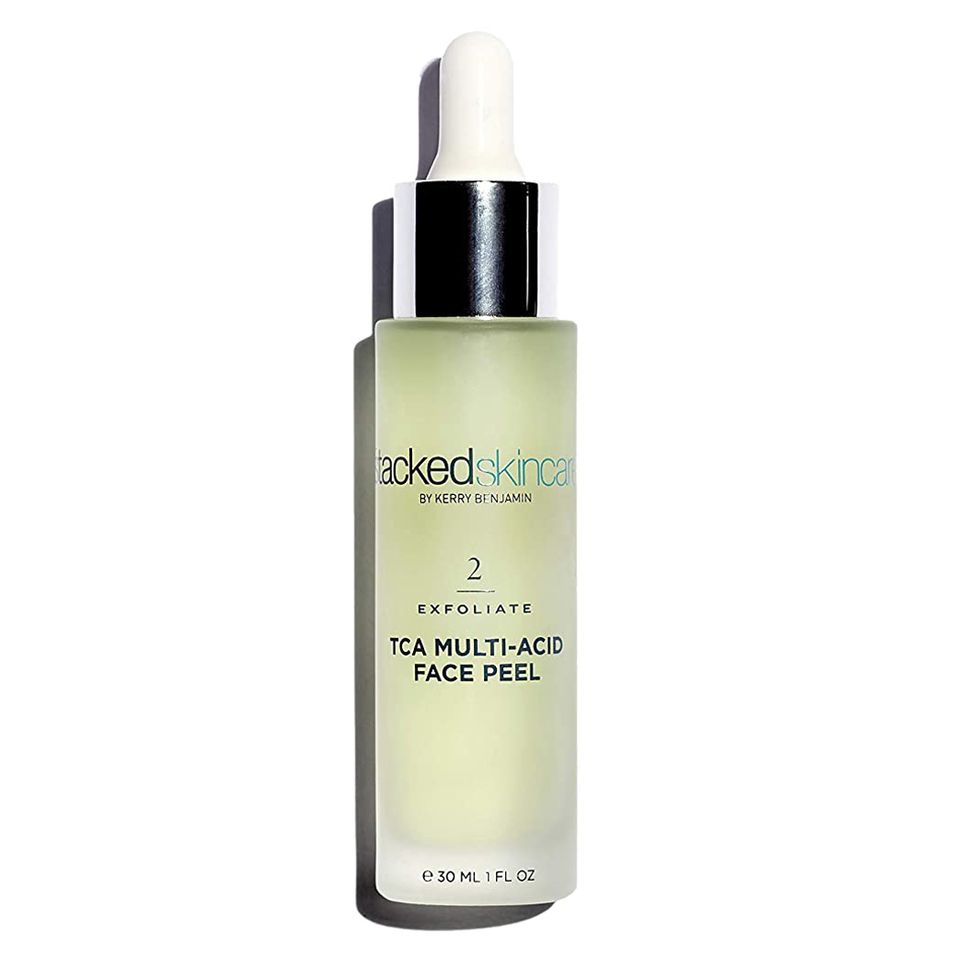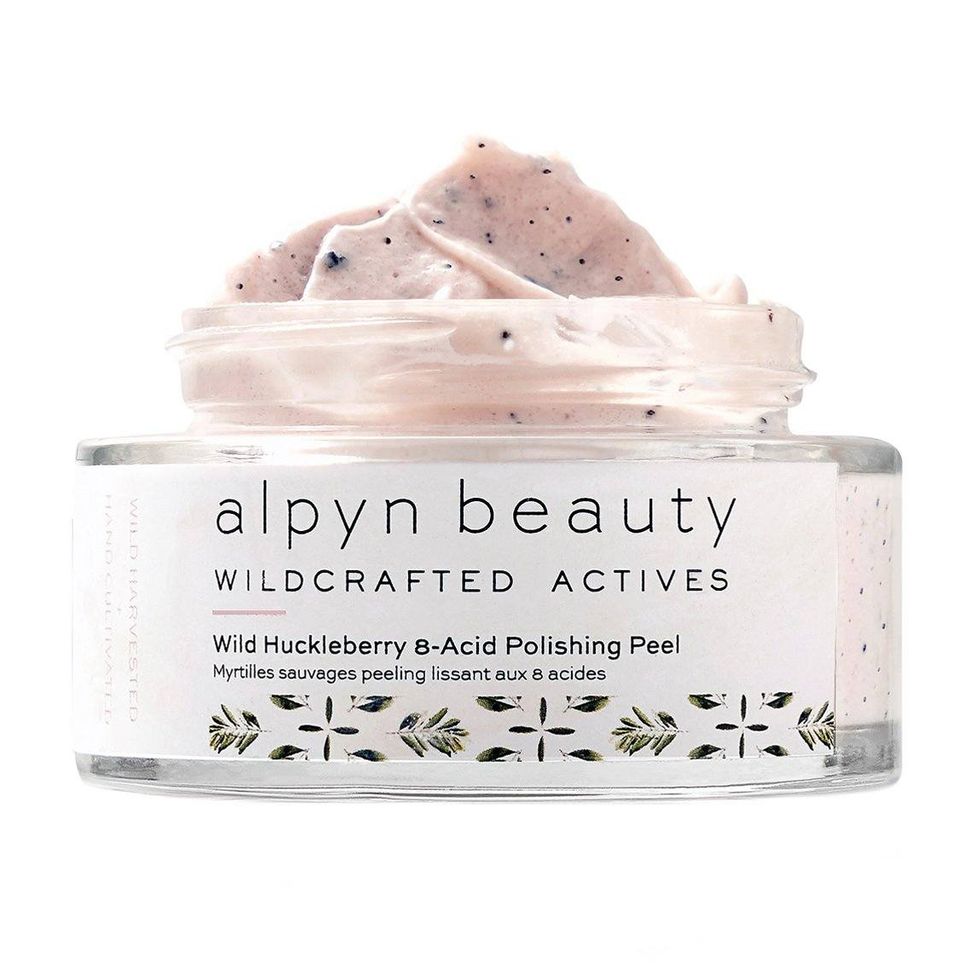Skin
An Expert Guide to Dermaplaning for More Radiant, Youthful-Looking Skin
Yes, we’re talking face shaving, and no, it’s not as crazy as it sounds.

08 October, 2020
10 November, 2021
No matter what daily cleanser you use, without proper exfoliation your skin can still wind up lackluster, flaky, and compromised. But of course, over-exfoliation can destroy your fragile microbiome, throw your skin’s pH out of whack, and lead to even more peeling and irritation. So how can we safely and effectively rid our skin of dead skin, dirt, oil, and buildup (and therefore achieve that smooth, supple skin we dream of)? By shaving our faces.
Now, hold on—don’t reach for your BiC disposable razor just yet. Dermaplaning is an in-office treatment that involves an aesthetician lightly shaving your face with a medical-grade scalpel to remove dead skin cells and peach fuzz from the skin. Through this thorough physical exfoliation, people can see significant improvement in their textural scarring, hyperpigmentation, acne, fine lines and wrinkles, and general dewiness throughout the day. Additionally, given that this treatment removes the dry and flaky top layer of the skin, skin-care products can better penetrate the layers of the skin, and makeup has a smooth, even canvas to help it look as natural as possible. We would also like to report that dermaplaning is, in essence, shaving, so it is as pain-free as shaving your legs.
Although it’s wise to visit a professional for your treatment (especially if you’re new to dermaplaning), it’s also totally feasible to dermaplane at home as well. But if you’re apprehensive, we understand—there are multiple misconceptions surrounding the beauty treatment, especially the myth that your hair will grow back thicker and darker.
Says Kerry Benjamin, aesthetician and CEO of StackedSkincare, “[Dermaplaning] does remove that vellus hair. It’s a complete myth that your hair grows back thicker or darker. Your hair grows back with a blunt edge, so it will seem thicker initially. But if you just let it grow out for a couple more days, it will be exactly like it was before: those vellus, [peach-fuzz-like] hairs.” Just as your ends feel thicker after a haircut, but are not actually growing back thicker, the hair on your face will never grow back into a thick, dark beard.
Additionally, the act of dermaplaning itself will not lead to breakouts (as some people might think), but the steps a person takes before, during, and after treatment might. “Dermaplaning itself, if done the right way, should not cause a purge,” says Dr. Joshua Zeichner, director of cosmetic and clinical research in dermatology at Mount Sinai Hospital. He explains, “Any pre- or post-dermaplaning moisturizers could cause breakouts if they contain heavy oils, [and] any nicks in the skin caused by dermaplaning could lead to inflammation that causes an acne flare.” In short, if done the right way and with the proper pre- and post-care, all you should see is glowing and radiant skin after a good dermaplaning session.
As far as who is a suitable candidate for dermaplaning, Benjamin reveals that this practice is safe for most people, even those with sensitive skin. However, if you do have a skin infection, Dr. Zeichner recommends to avoid dermaplaning. He states, “Infectious bacteria, like staph, can be spread with a dermaplaning device, leading to skin infections.”
Benjamin adds, “If you have cystic acne sitting under the surface of the skin, it’s totally fine to go over that area. The only people that shouldn’t really do it are people with active, pustular acne.” Dr. Zeichner elaborates, “Acne is not an infection, and dermaplaning will not spread any acne-causing bacteria leading to acne flares. In fact, the acne-causing bacteria, C. acnes, does not live on the surface of the skin.” So you *technically* will not see more breakouts in other parts of the skin if you do dermaplane over active acne, but you will still want to avoid these areas.
However, Dr. Zeichner explains that dermaplaning over an active pimple will rupture the breakout, irritate the area, and lead to post-inflammatory hyperpigmentation, or acne scarring (which is a pain to conquer). Both he and Benjamin agree that if you do have active zones of acne, it is best to only dermaplane the areas of the face that are breakout-free, and to maneuver the device around the active zones.
And above all, it’s essential to invest in a proper dermaplane tool that actually mimics the scalpel used during in-office treatments—your single-use razor is not the answer here—and to change the blade regularly when it is dull. We recommend switching it out after every three to four sessions, and in between be sure to wipe the blade clean of any residue with a paper towel and disinfect after each use with a quick spritz of isopropyl alcohol (you don’t want to accidentally nick yourself down the line and allow bacteria to enter your skin and cause an infection). After your tool is dry, store it in a cool and dry place.
Now, hold on—don’t reach for your BiC disposable razor just yet. Dermaplaning is an in-office treatment that involves an aesthetician lightly shaving your face with a medical-grade scalpel to remove dead skin cells and peach fuzz from the skin. Through this thorough physical exfoliation, people can see significant improvement in their textural scarring, hyperpigmentation, acne, fine lines and wrinkles, and general dewiness throughout the day. Additionally, given that this treatment removes the dry and flaky top layer of the skin, skin-care products can better penetrate the layers of the skin, and makeup has a smooth, even canvas to help it look as natural as possible. We would also like to report that dermaplaning is, in essence, shaving, so it is as pain-free as shaving your legs.
Although it’s wise to visit a professional for your treatment (especially if you’re new to dermaplaning), it’s also totally feasible to dermaplane at home as well. But if you’re apprehensive, we understand—there are multiple misconceptions surrounding the beauty treatment, especially the myth that your hair will grow back thicker and darker.
Says Kerry Benjamin, aesthetician and CEO of StackedSkincare, “[Dermaplaning] does remove that vellus hair. It’s a complete myth that your hair grows back thicker or darker. Your hair grows back with a blunt edge, so it will seem thicker initially. But if you just let it grow out for a couple more days, it will be exactly like it was before: those vellus, [peach-fuzz-like] hairs.” Just as your ends feel thicker after a haircut, but are not actually growing back thicker, the hair on your face will never grow back into a thick, dark beard.
Additionally, the act of dermaplaning itself will not lead to breakouts (as some people might think), but the steps a person takes before, during, and after treatment might. “Dermaplaning itself, if done the right way, should not cause a purge,” says Dr. Joshua Zeichner, director of cosmetic and clinical research in dermatology at Mount Sinai Hospital. He explains, “Any pre- or post-dermaplaning moisturizers could cause breakouts if they contain heavy oils, [and] any nicks in the skin caused by dermaplaning could lead to inflammation that causes an acne flare.” In short, if done the right way and with the proper pre- and post-care, all you should see is glowing and radiant skin after a good dermaplaning session.
As far as who is a suitable candidate for dermaplaning, Benjamin reveals that this practice is safe for most people, even those with sensitive skin. However, if you do have a skin infection, Dr. Zeichner recommends to avoid dermaplaning. He states, “Infectious bacteria, like staph, can be spread with a dermaplaning device, leading to skin infections.”
Benjamin adds, “If you have cystic acne sitting under the surface of the skin, it’s totally fine to go over that area. The only people that shouldn’t really do it are people with active, pustular acne.” Dr. Zeichner elaborates, “Acne is not an infection, and dermaplaning will not spread any acne-causing bacteria leading to acne flares. In fact, the acne-causing bacteria, C. acnes, does not live on the surface of the skin.” So you *technically* will not see more breakouts in other parts of the skin if you do dermaplane over active acne, but you will still want to avoid these areas.
However, Dr. Zeichner explains that dermaplaning over an active pimple will rupture the breakout, irritate the area, and lead to post-inflammatory hyperpigmentation, or acne scarring (which is a pain to conquer). Both he and Benjamin agree that if you do have active zones of acne, it is best to only dermaplane the areas of the face that are breakout-free, and to maneuver the device around the active zones.
And above all, it’s essential to invest in a proper dermaplane tool that actually mimics the scalpel used during in-office treatments—your single-use razor is not the answer here—and to change the blade regularly when it is dull. We recommend switching it out after every three to four sessions, and in between be sure to wipe the blade clean of any residue with a paper towel and disinfect after each use with a quick spritz of isopropyl alcohol (you don’t want to accidentally nick yourself down the line and allow bacteria to enter your skin and cause an infection). After your tool is dry, store it in a cool and dry place.
Are you sold yet? We are, which is why we’ve been dermaplaning our faces for years. Explore the professional-recommended technique for face shaving below.
This is an important step because you want to scrape the skin, and only the skin, without makeup, grime, or leftover SPF getting in the way. If your skin is not clean, you might run the risk of only scraping off the products sitting on top of your face, not the dead skin cells underneath. Says Benjamin, “You want to have your skin clean and dry. Typically, the drier, the better, because that’s how you really remove the most dead skin and peach fuzz. Some people do an oil technique, [but] I find that to be not as effective—it’s more like you’re just shaving your hair off as opposed to actually exfoliating your skin.”
Step 1: Cleanse and Dry the Skin
This is an important step because you want to scrape the skin, and only the skin, without makeup, grime, or leftover SPF getting in the way. If your skin is not clean, you might run the risk of only scraping off the products sitting on top of your face, not the dead skin cells underneath. Says Benjamin, “You want to have your skin clean and dry. Typically, the drier, the better, because that’s how you really remove the most dead skin and peach fuzz. Some people do an oil technique, [but] I find that to be not as effective—it’s more like you’re just shaving your hair off as opposed to actually exfoliating your skin.”
Step 2: Know Your Angles
Says Benjamin, “The most important thing is the placement of the blade on your skin and having your hand behind the blade pulling it taut.” Once your face is dry and product-free, hold your skin tight to avoid any nicks on rounded or crepey surfaces of the skin. Then hold the dermaplaning tool at a forty-five-degree angle against the skin. That will help you (safely) eliminate all the unwanted hair and dead skin in one pass.
Step 3: Determine Your Starting Point
Benjamin reveals that although you can technically start dermaplaning anywhere on your face, the cheek is the best place. Its flat and broad nature allows for you to practice the technique without nicking yourself on any round angles (which are inherently trickier to shave). Once you have a proper feel for gliding the dermaplaning tool on your face, continue to your chin area, upper lip area, and forehead.
Step 4: Scrape, but Never Lift
Using a single stroke, gently scrape at the skin in one direction. During this stroke, you want to use short movements to sweep over the area without ever lifting the tool until the stroke is complete, as lifting the tool mid-stroke can result in unnecessary nicking. Imagine starting a dermaplaning session at your jaw—without lifting the tool from your skin, you will use short sweeps until you reach the top of your cheekbone. When that stroke is complete is when you can lift the tool and move on to the next area.
Additionally, Benjamin points out that whether you are going upward, downward, or diagonally, the direction itself does not affect the results of dermaplaning as much as holding the skin taut and holding the tool at the right angle, so go in whichever direction feels right for you.
Benjamin recommends to avoid using this device on the eye area or the bridge of the nose to decrease the chances of accidentally nicking your skin.
Step 5: Apply Your Products
According to Benjamin, a dermaplaning session in a professional setting typically ends with a quick chemical peel to remove any lingering dead skin cells and reveal the bright, youthful skin below. After you’re done with your entire face (and your neck as well if you want, moving downward from the jawline in the same short strokes), apply a gentle peel or an AHA/BHA exfoliating toner (depending on what you think your skin can handle) to the face with a reusable cotton round. It might sting a little, but it should dissipate in a few seconds. Then remove after the recommended amount of time with a damp cloth, and follow with your favorite moisturizer or oil. Just make sure to avoid using harsh acids and retinoids on a dermaplaning night, as that can wreak havoc on the cell turnover process.
And as a reminder—dermaplaning is an intense form of physical exfoliation and is not meant to be a nightly routine. Although we’d love to sport the post-dermaplaning glow every day, over-exfoliation can be detrimental to your skin’s lipid barrier. Benjamin recommends dermaplaning every two weeks, or however long it takes to see significant regrowth of your hair.
Photo: Shot on site at 6 Columbus, a Sixty Hotel. On Solveig: Rings, Baker & Black, Azlee; Hair, Angela Soto; Makeup, Andriani.
Want more stories like this?
So You Have Melasma–Now What?
Face Tools Our Editors Swear By for Gorgeous Skin
This $12 DIY Turmeric Mask Gave Me Picture Perfect Skin
Photo: Shot on site at 6 Columbus, a Sixty Hotel. On Solveig: Rings, Baker & Black, Azlee; Hair, Angela Soto; Makeup, Andriani.
Want more stories like this?
So You Have Melasma–Now What?
Face Tools Our Editors Swear By for Gorgeous Skin
This $12 DIY Turmeric Mask Gave Me Picture Perfect Skin








